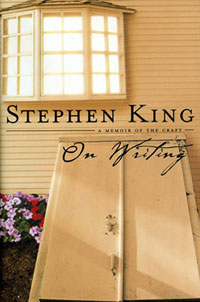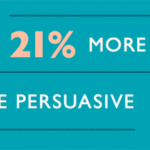Writing: I’ve done it all my life, and I’ve earned a living through doing it well. But I’ve taken it for granted.
 Occasionally, I read an article with writing advice. Some are above average, many are so-so. But for years, I have neglected a great book on my shelf called “On Writing” [aff. link]. A gift from a friend, the book offers advice and a short autobiography from one of America’s most notable writers, Stephen King.
Occasionally, I read an article with writing advice. Some are above average, many are so-so. But for years, I have neglected a great book on my shelf called “On Writing” [aff. link]. A gift from a friend, the book offers advice and a short autobiography from one of America’s most notable writers, Stephen King.
The target audience is fiction writers, but any storyteller can learn from his tips. Every marketer who dabbles in writing can grow with King’s help.
Working on writing makes it easier on us to create compelling copy, easing the struggle of sitting before a blank screen. It also enhances our storytelling, improving our odds of reaching potential customers through our blogs, emails and social media posts.

Stephen King
Read a lot.
King points out that authors truly devoted to the craft must also be heavy readers. It comes with the job.
“Reading is the creative center of a writer’s life.”
He believes in it so much that not only does he show how to cram in more reading (waiting rooms, long lines, bathrooms, treadmills, driving with audiobooks) but also offers a list of nearly 100 books for suggested reading.
We learn from other writers, good and bad: little flourishes of style, approaches to complex topics and perhaps most important, what not to do. Thanks to long roadtrips this year, I’ve listened to several good books and many interesting longform articles.
Bonus: How to triple your reading.
Write a lot.
King says as much in first laying out his advice.
“If you want to be a writer, you must do two things above all others: Read a lot, and write a lot.”
See?
I’ve kept a vow to myself to write as much as possible through different stages of my career. At a daily newspaper, I invested my writing in my weekly column, in headlines, in rewriting reporters’ copy (though I usually had them do it when time permitted) and in memos. Yes, memos. Why write something most colleagues will ignore when a small dose of creative energy will make it, at the least, skim-worthy?
Outside of a newsroom, I have other ways to keep in writing shape. For 11 years, I have written a haiku a day on my original blog. I write several blog posts a week, as well as two weekly newsletters and dozens of tweets, which are especially helpful in keeping it tight.
We can all find ways to spend a little more time on writing: important emails, ad copy, Facebook events, a note to a friend or a coworker. It is this devotion to practice that takes us from mediocre to good, from good to great.
Bonus: For those who want to practice, starting a WordPress.com blog is a free and easy way to get in the writing habit. The site can be under a pseudonym or even locked down in private mode. Writing one thing a day from a computer or phone starts the routine of putting something, anything into words. It can be a grocery list, a misremembered favorite quote, a funny line from binge-watching, directions to the post office. Remember: The idea is to write write write.
Cut the word count by 10 percent.
King churns out a first draft through focused and uninhibited writing. He starts out in his career with short stories and works up to novellas and novels. Along the way, he learns to trim his copy after letting his manuscript sit a while.
If he writes 20,000 words, he knows he can cut 2,000 and no one would miss them. In fact, his stories improve, and readers rejoice. “Omit needless words,” King quotes repeatedly from the premier writing and editing guide, “The Elements of Style” [aff. link]. I am long overdue for reading this book again.
He takes the reader through a couple of examples in trimming a first draft, explaining each editing choice.
I often hold writers to a stricter rule: Cut by a third. A reporter or a blogger who turns in a 600-word piece to me ends up chopping it mercilessly to 400 words. It makes them better writers and helps them excise the flabby prose that had become a crutch.
Another approach I’ve picked up is to simply cut the first paragraph. In editing a friend’s article this week for publication, I have advised dropping the first two paragraphs. We sometimes use the opening paragraph as throat clearing, without offering anything vital to the work itself.
Bonus: We can all practice our editing by taking the last blog post, whether from yesterday or 6 months ago, and cutting it by 10 percent.
I have learned a lot about Stephen King the writer and the mentor from “On Writing.” Marketers and storytellers uninterested in his life story can skip the first third of the book and go straight to the advice, starting with “What Writing Is.”
Even those who dabble may find inspiration to at long last try their hand at writing their first fiction masterpiece.
Video: Stephen King discusses character, plot, ideas and process in creative writing.
•
P.S. This blog is available by Kindle subscription for less than a dollar a month.







Every writer should read On Writing and keep Elements of Style at hand. My absolute favorites! Thanks, Wade.
Thanks, Lallie!